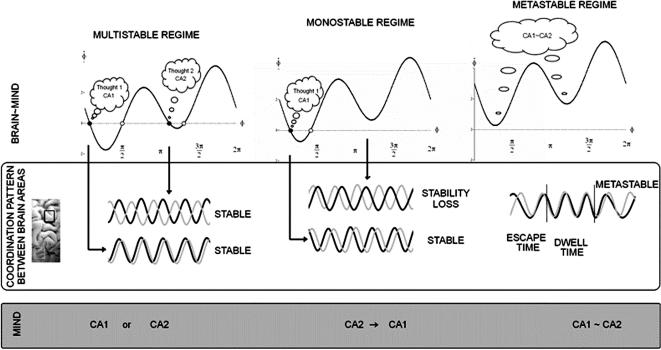FIGURE 4.
Sketch of a dynamical law of thought and thinking (with homage to Boole, 1854/2005). Middle panel represents synaptically coupled brain oscillations from two brain areas (for the sake of simplicity) whose activation is meaningful and specific to the content of “thoughts.” Here “thought” is used in a generic sense; the states could refer to patterns of perceiving, emoting, remembering, deciding, acting, and so on. Top left panel shows the layout of the fixed points of the relative phase dynamics (Eq. 1) in the multi- (here bi-)stable regime. Solid circles are stable and attracting; open circles are unstable and repelling (see also Figure 2). Two states are stable, corresponding to particular phase relations between oscillatory groups of neurons, representing two stable “thought” patterns (ca1 and ca2) for exactly the same parameter values. Which one is realized depends on initial and boundary conditions. Many factors—developmental, social, cultural, learning, memory, and so on—may contribute to the process of stabilizing brain coordination states. Top middle panel shows that the formerly stable pattern near antiphase switches to near inphase as a result of changing circumstances. Any ambiguity due to bistability has been removed, a “decision” or “selection” has been made, and as a result, the system is monostable, stuck in one thought pattern. The switching mechanism is dynamic instability induced by changing control parameters (e.g., the coupling between the neural populations, which may be altered by neuromodulators). Fluctuations (not explicitly represented here) also play a key role in spontaneous switching. Top right panel shows that all states, both stable and unstable, have disappeared. This is the metastable régime. Now “thoughts” no longer correspond to fixed point, fully synchronized states of the coordination dynamics but rather to coexisting tendencies or dispositions that have characteristic dwell times. The lowest panel, called “Mind,” illustrates the classical dual nature of either/or, binary oppositions (ca1 or ca2), mind (and mind-set), switching (ca2 to ca1 and vice versa), and the mind and mind-set of the complementary nature, where both “thoughts” are held in the mind at the same time (ca1∼ca2). Even polarization∼reconciliation may be considered a complementary pair.

